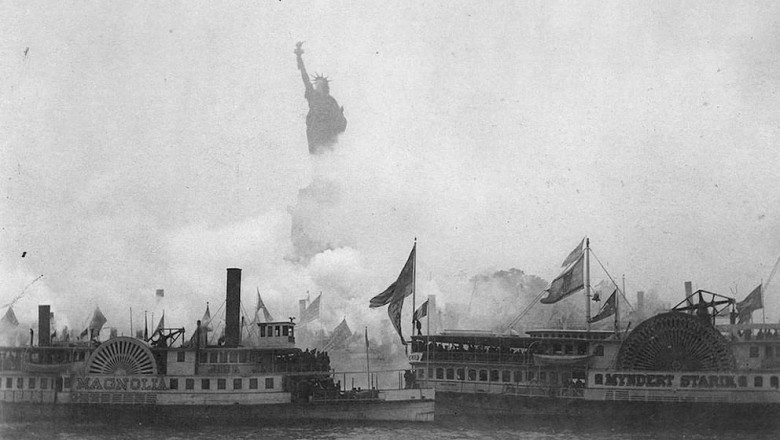The inauguration of the Statue of Liberty in 1886 was a momentous event, symbolizing freedom and democracy. This colossal statue, officially titled "Liberty Enlightening the World," was a gift from the people of France to the United States, conceived to celebrate the enduring friendship between the two nations and to commemorate the centennial of American independence. The event marked a significant milestone in the history of both countries, reflecting their shared values and aspirations.
The idea for the statue was first proposed by Édouard René de Laboulaye, a French political thinker and staunch supporter of the Union during the American Civil War. Laboulaye envisioned the statue as a symbol of liberty and a celebration of the success of the American democratic experiment. French sculptor Frédéric Auguste Bartholdi was commissioned to design the statue, and he, along with engineer Gustave Eiffel, who later designed the Eiffel Tower, took on the monumental task of bringing this vision to life.
The statue itself is a masterpiece of design and engineering. Standing at 305 feet (93 meters) from the base to the tip of the torch, Lady Liberty holds a torch in her right hand and a tablet in her left, inscribed with the date of the American Declaration of Independence: July 4, 1776. The broken chains at her feet symbolize the abolition of slavery and the triumph of freedom over oppression. The statue's copper exterior, originally a reddish-brown color, has since developed a green patina due to oxidation, giving it the iconic appearance we recognize today.
The construction of the statue was a massive undertaking, requiring the collaboration of numerous artists, craftsmen, and engineers. In France, pieces of the statue were constructed and then disassembled for shipment to the United States. The statue was transported across the Atlantic Ocean in 214 crates, arriving in New York Harbor on June 17, 1885. Over the following months, the pieces were reassembled on Liberty Island, formerly known as Bedloe's Island.
The dedication ceremony for the Statue of Liberty took place on October 28, 1886. Despite heavy rain, a large crowd gathered to witness the historic event. President Grover Cleveland presided over the ceremony, declaring that the statue "will be cherished by untold millions of our race who shall seek liberty from oppression." The ceremony included speeches by dignitaries from both the United States and France, emphasizing the deep bond between the two nations and their shared commitment to the principles of liberty and democracy.
The unveiling of the statue was a grand spectacle. As the statue was draped with a French flag, Bartholdi himself stood inside the statue's head, ready to drop the flag and reveal Lady Liberty to the world. When the moment came, the crowd erupted in cheers, and cannons fired a 21-gun salute. The statue's torch was illuminated for the first time, shining as a beacon of hope and freedom for all who would see it.
The Statue of Liberty quickly became a symbol of hope and opportunity for immigrants arriving in the United States. For millions of people fleeing poverty, persecution, and oppression in their home countries, the sight of Lady Liberty standing tall in New York Harbor was a powerful reminder of the promise of a better life. The statue's proximity to Ellis Island, the primary immigration station for the United States from 1892 to 1954, further cemented its association with the immigrant experience.
The legacy of the Statue of Liberty extends far beyond its physical presence. It has become a global symbol of freedom, democracy, and human rights. The statue has been the backdrop for countless historical events and movements, including the women's suffrage movement, the civil rights movement, and more recently, discussions about immigration and equality. Its enduring significance continues to inspire people around the world to strive for a more just and equitable society.
In conclusion, the inauguration of the Statue of Liberty in 1886 was a landmark event that celebrated the enduring friendship between France and the United States and the shared values of liberty and democracy. The statue stands as a testament to the power of collaboration and the enduring human spirit. Its iconic presence continues to inspire and remind us of the importance of freedom and equality for all. The story of the Statue of Liberty is a story of hope, resilience, and the enduring pursuit of a better future.

